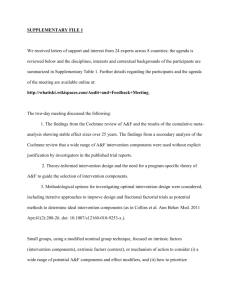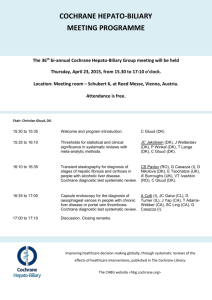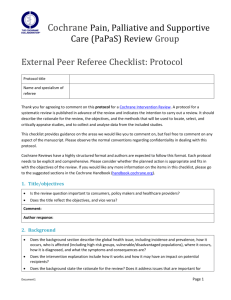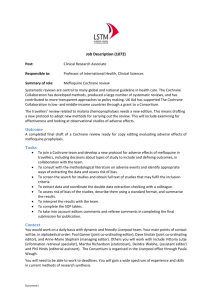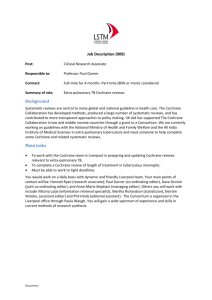methods guide checklist
advertisement
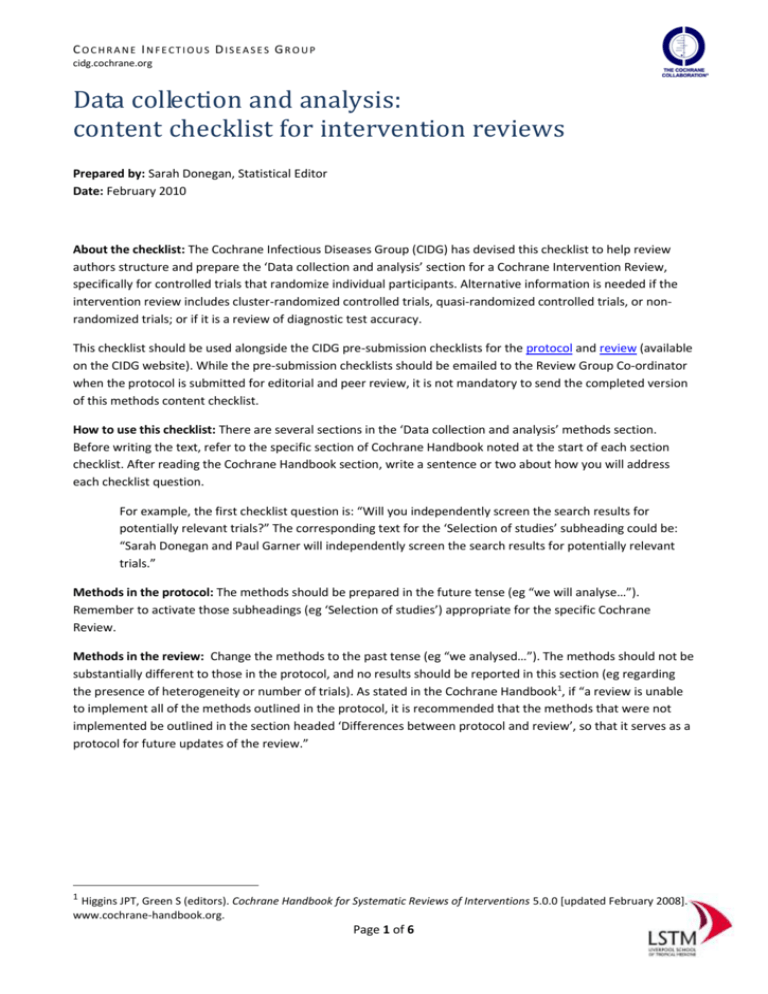
COCHRANE INFECTIOUS DISEASES GROUP cidg.cochrane.org Data collection and analysis: content checklist for intervention reviews Prepared by: Sarah Donegan, Statistical Editor Date: February 2010 About the checklist: The Cochrane Infectious Diseases Group (CIDG) has devised this checklist to help review authors structure and prepare the ‘Data collection and analysis’ section for a Cochrane Intervention Review, specifically for controlled trials that randomize individual participants. Alternative information is needed if the intervention review includes cluster-randomized controlled trials, quasi-randomized controlled trials, or nonrandomized trials; or if it is a review of diagnostic test accuracy. This checklist should be used alongside the CIDG pre-submission checklists for the protocol and review (available on the CIDG website). While the pre-submission checklists should be emailed to the Review Group Co-ordinator when the protocol is submitted for editorial and peer review, it is not mandatory to send the completed version of this methods content checklist. How to use this checklist: There are several sections in the ‘Data collection and analysis’ methods section. Before writing the text, refer to the specific section of Cochrane Handbook noted at the start of each section checklist. After reading the Cochrane Handbook section, write a sentence or two about how you will address each checklist question. For example, the first checklist question is: “Will you independently screen the search results for potentially relevant trials?” The corresponding text for the ‘Selection of studies’ subheading could be: “Sarah Donegan and Paul Garner will independently screen the search results for potentially relevant trials.” Methods in the protocol: The methods should be prepared in the future tense (eg “we will analyse…”). Remember to activate those subheadings (eg ‘Selection of studies’) appropriate for the specific Cochrane Review. Methods in the review: Change the methods to the past tense (eg “we analysed…”). The methods should not be substantially different to those in the protocol, and no results should be reported in this section (eg regarding the presence of heterogeneity or number of trials). As stated in the Cochrane Handbook1, if “a review is unable to implement all of the methods outlined in the protocol, it is recommended that the methods that were not implemented be outlined in the section headed ‘Differences between protocol and review’, so that it serves as a protocol for future updates of the review.” 1 Higgins JPT, Green S (editors). Cochrane Handbook for Systematic Reviews of Interventions 5.0.0 [updated February 2008]. www.cochrane-handbook.org. Page 1 of 6 COCHRANE INFECTIOUS DISEASES GROUP cidg.cochrane.org Selection of studies Read section 7.2 of the Cochrane Handbook: Selecting studies. Will you independently screen the search results for potentially relevant trials? Will you retrieve the corresponding full articles? Will you assess eligibility using an eligibility form? Who will assess eligibility? Will you assess eligibility independently from each other? Will you write to the trial authors regarding eligibility if eligibility is unclear? How will you resolve discrepancies between the eligibility results of the review authors? Will each of the trial's reports be scrutinized to ensure that multiple publications from the same trial are included only once? Will you list the excluded studies and the reasons for their exclusion? Data extraction and management Read sections 7.3 to 7.8 of the Cochrane Handbook: What data to collect; Sources of data; Data collection forms; Extracting data from reports; Extracting study results and converting to the desired format; and Managing data. There are two types of information to include in this section, one around general data extraction processes and the other about the type of data to be extracted. Before writing this section, decide which types of outcome data are potentially relevant to your review and do not describe data extraction for irrelevant outcomes. Refer to section 9.2.1 of the Cochrane Handbook: Types of data. About the general data extraction process Who will extract data? Will you independently extract data? Will you use data extraction forms? Will you pre-pilot the form? How will you resolve any differences in the data extraction? Will you contact the publication author in the case of unclear or missing data? About the type of data to be extracted Will you extract the number randomized and the numbers analysed in each treatment group, for each outcome? What data will you extract for dichotomous outcomes? For example, the number of participants experiencing the event and the number of participants in each treatment group? Refer to section 7.7.2 of the Cochrane Handbook: Data extraction for dichotomous outcomes. What data will you extract for continuous outcomes? For example, arithmetic means and standard deviations for each treatment group together with the numbers of participants in each group. If the data have been reported using geometric means, record this information and extract a standard error on the log scale. If medians have been used, extract medians and aim to also extract ranges. Refer to section 7.7.3 of the Cochrane Handbook: Data extraction for continuous outcomes. Page 2 of 6 COCHRANE INFECTIOUS DISEASES GROUP cidg.cochrane.org What data will you extract for count data outcomes? For example, extract the number of events in the treatment and control group and the total person time at risk in each group or the rate ratio and a measure of variance (eg standard error) directly from the trial report. Refer to section 7.7.5 of the Cochrane Handbook: Data extraction for counts. What data will you extract for time to event data outcomes? For example, extract the hazard ratio and a measure of variance directly from the trial report. Refer to section 7.7.6 of the Cochrane Handbook: Data extraction for time-to-event outcomes. Assessment of risk of bias in included studies Read section 8 of the Cochrane Handbook: Assessing risk of bias in included studies. Who assessed risk of bias? Was risk of bias assessed independently? Will you use an assessment form? Will you attempt to contact the authors for any information not specified or unclear? How will you resolve any disagreements? Which components will you assess? Note: You should address six components: sequence generation; allocation concealment; blinding; incomplete outcome data; selective outcome reporting; and other biases. What will you describe for each trial for each component? For example for sequence generation and allocation concealment, describe the methods used; and for blinding, describe who was blinded and the blinding method. For incomplete outcome data: report the percentage and proportion loss to follow up (the number of participants for whom outcomes are measured/the number randomized) and any other relevant information. For selective outcome reporting, you could state any discrepancies between the methods and the results in terms of the outcomes measured and the outcomes reported; or identify any outcome that you know would have been measured but was not reported in the publication. For other biases: describe any other trial features that you think could affect the trial’s results (eg trial stopped early, no sample size calculation etc). Will you assign judgments concerning the risk of bias for each component? How? For example, judgments are classified as “yes”, “no” or “unclear” indicating a low, high, or unclear/unknown risk of bias respectively. Will you group the outcomes in the assessment? The Cochrane Handbook states that one judgment should be assigned for each study for sequence generation, allocation concealment, selective outcome reporting, and other biases. For blinding and incomplete outcome data, one judgment per outcome in the trial should be assigned. Alternatively, if there are many outcomes, you could group the secondary outcomes and assess them together as described in the Cochrane Handbook (eg subjective outcomes) could be grouped. How will you record the results? There are two useful summary graphs which are easy to display and save: ‘risk of bias summary’ and ‘risk of bias graph; in addition to the risk of bias tables. Page 3 of 6 COCHRANE INFECTIOUS DISEASES GROUP cidg.cochrane.org Measures of treatment effect Read sections 9.1 and 9.2 of the Cochrane Handbook: Introduction to analysing data and undertaking meta-analysis; and Types of data and effect measures. In this section describe the measures of effect that will be used for each type of outcome that you decided was potentially relevant when writing the Data extraction and Management section. What measure of effect will you use to compare dichotomous data? The risk ratio is recommended generally, although in some case the odds ratio or risk difference is more appropriate. Refer to sections 9.2.2 and 9.4.4 of the Cochrane Handbook: Effect measures for dichotomous outcomes; and Meta-analysis of dichotomous outcomes. What measure of effect will you use to compare continuous data? If continuous data are summarized by arithmetic means and standard deviations, present the mean differences. Where continuous data are summarized using geometric means, report geometric mean ratios. Medians and ranges should be reported in a table. See sections 9.2.3 and 9.4.5 of the Cochrane Handbook: Effect measures for continuous outcomes; and Meta-analysis of continuous outcomes What measure of effect will you use to compare count data? Rate ratios are often used to combine count data. Rate ratios can be calculated manually if they are not reported in the trial reports. Refer to sections 9.2.5 and 9.4.8 of the Cochrane Handbook: Effect measures for counts and rates; and Meta-analysis of counts and rates. What measure of effect will you use to compare time to event data? Hazard ratios are used to compare time to event data. Refer to sections 9.2.6 and 9.4.9 of the Cochrane Handbook: Effect measures for time-to-event (survival) outcomes; and Meta-analysis of time-to-event outcomes. Will all results be presented with 95% confidence intervals? Unit of analysis issues Read section 9.3 of the Cochrane Handbook: Study designs and identifying the unit of analysis. If you anticipate that trials will be multi-armed, how will you account for this in the analysis? Note that the same group of participants cannot be combined in the same meta-analysis more than once. Dealing with missing data Read sections 16.1 and 16.2 of the Cochrane Handbook: Missing data; and Intention -to-treat issues. If there is missing data what type of analysis will you apply e.g. complete case, intention to treat? A complete-case analysis is generally recommended if there are missing data. What type of analysis will you carry out if there is no missing data? Aim to carry out analyses according to the intention-to-treat principle if there are no missing data. Page 4 of 6 COCHRANE INFECTIOUS DISEASES GROUP cidg.cochrane.org Assessment of heterogeneity Read section 9.5 of the Cochrane Handbook: Heterogeneity. How will you assess heterogeneity? How will you determine there is statistically significant heterogeneity? One approach is to inspect the forest plots to detect overlapping confidence intervals, to apply the chi-squared test with a P value of 0.10 used to indicate statistical significance, and also to implement the I2 test statistic with a value of 50% used to denote moderate levels of heterogeneity. See section 9.5.2 of the Cochrane Handbook: Identifying and measuring heterogeneity. Assessment of reporting biases Read section 10 of the Cochrane Handbook: Addressing reporting biases. If there are sufficient trials (about 10) will you construct funnel plot to look for evidence of publication bias? Data synthesis Read section 9.4 of the Cochrane Handbook: Summarizing effects across studies Although you do not need to describe the specific models used to analyse data, you are required to understand them in some respects to analyse data in Review Manager 5. The model used will depend on the type of data and whether a fixed-effect approach or random-effects approach is undertaken. For example, dichotomous data is often combined using the Mantel-Haenszel method; and continuous, count and time to event data are each combined using the inverse variance approach. Who will analyse the data using Review Manager 5? Will you stratify analyses according to any feature (eg control) used? How will you decide when to use the fixed-effect model and when to use the random-effects model? When will you conclude there is too much heterogeneity to combine trials in a meta-analysis? See sections 9.5.3 and 9.5.4 of the Cochrane Handbook: Strategies for addressing heterogeneity; and incorporating heterogeneity into random-effects models. Subgroup analysis and investigation of heterogeneity Read section 9.6 of the Cochrane Handbook: Investigating heterogeneity. Will you investigate heterogeneity using subgroup analyses? Providing there are sufficient trials, will you investigate heterogeneity using meta-regression? Note that meta-regression cannot be carried out in Review Manager 5. Which variables will you consider in these analyses? How will you determine if there is too much clinical heterogeneity to combine trials? Sensitivity analysis Read section 9.7 of the Cochrane Handbook: Sensitivity analyses. Providing there are sufficient trials, will you carry out sensitivity analyses regarding risk of bias to investigate the robustness of the results to the risk of bias components? Will you investigate the effect of missing data using sensitivity analyses? Page 5 of 6 COCHRANE INFECTIOUS DISEASES GROUP cidg.cochrane.org Page 6 of 6


